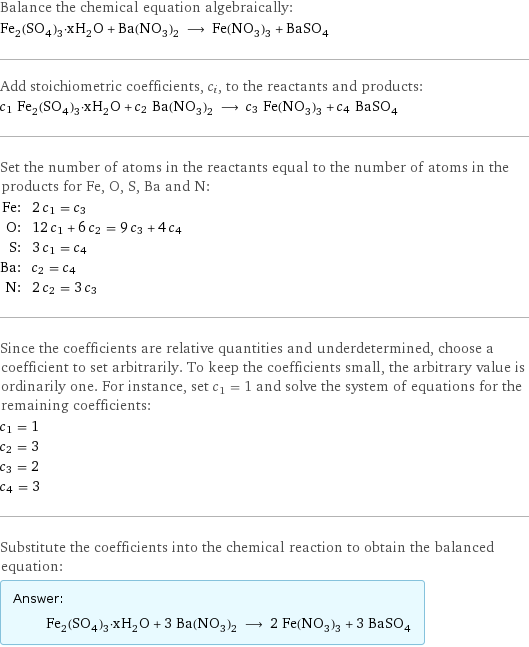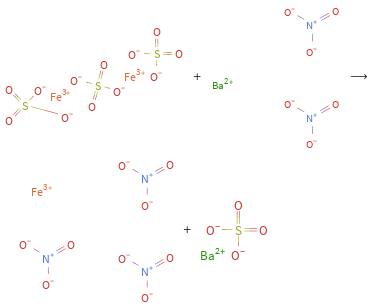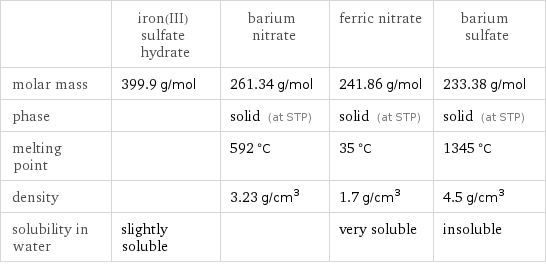Input interpretation

Fe_2(SO_4)_3·xH_2O iron(III) sulfate hydrate + Ba(NO_3)_2 barium nitrate ⟶ Fe(NO_3)_3 ferric nitrate + BaSO_4 barium sulfate
Balanced equation

Balance the chemical equation algebraically: Fe_2(SO_4)_3·xH_2O + Ba(NO_3)_2 ⟶ Fe(NO_3)_3 + BaSO_4 Add stoichiometric coefficients, c_i, to the reactants and products: c_1 Fe_2(SO_4)_3·xH_2O + c_2 Ba(NO_3)_2 ⟶ c_3 Fe(NO_3)_3 + c_4 BaSO_4 Set the number of atoms in the reactants equal to the number of atoms in the products for Fe, O, S, Ba and N: Fe: | 2 c_1 = c_3 O: | 12 c_1 + 6 c_2 = 9 c_3 + 4 c_4 S: | 3 c_1 = c_4 Ba: | c_2 = c_4 N: | 2 c_2 = 3 c_3 Since the coefficients are relative quantities and underdetermined, choose a coefficient to set arbitrarily. To keep the coefficients small, the arbitrary value is ordinarily one. For instance, set c_1 = 1 and solve the system of equations for the remaining coefficients: c_1 = 1 c_2 = 3 c_3 = 2 c_4 = 3 Substitute the coefficients into the chemical reaction to obtain the balanced equation: Answer: | | Fe_2(SO_4)_3·xH_2O + 3 Ba(NO_3)_2 ⟶ 2 Fe(NO_3)_3 + 3 BaSO_4
Structures

+ ⟶ +
Names

iron(III) sulfate hydrate + barium nitrate ⟶ ferric nitrate + barium sulfate
Equilibrium constant
![Construct the equilibrium constant, K, expression for: Fe_2(SO_4)_3·xH_2O + Ba(NO_3)_2 ⟶ Fe(NO_3)_3 + BaSO_4 Plan: • Balance the chemical equation. • Determine the stoichiometric numbers. • Assemble the activity expression for each chemical species. • Use the activity expressions to build the equilibrium constant expression. Write the balanced chemical equation: Fe_2(SO_4)_3·xH_2O + 3 Ba(NO_3)_2 ⟶ 2 Fe(NO_3)_3 + 3 BaSO_4 Assign stoichiometric numbers, ν_i, using the stoichiometric coefficients, c_i, from the balanced chemical equation in the following manner: ν_i = -c_i for reactants and ν_i = c_i for products: chemical species | c_i | ν_i Fe_2(SO_4)_3·xH_2O | 1 | -1 Ba(NO_3)_2 | 3 | -3 Fe(NO_3)_3 | 2 | 2 BaSO_4 | 3 | 3 Assemble the activity expressions accounting for the state of matter and ν_i: chemical species | c_i | ν_i | activity expression Fe_2(SO_4)_3·xH_2O | 1 | -1 | ([Fe2(SO4)3·xH2O])^(-1) Ba(NO_3)_2 | 3 | -3 | ([Ba(NO3)2])^(-3) Fe(NO_3)_3 | 2 | 2 | ([Fe(NO3)3])^2 BaSO_4 | 3 | 3 | ([BaSO4])^3 The equilibrium constant symbol in the concentration basis is: K_c Mulitply the activity expressions to arrive at the K_c expression: Answer: | | K_c = ([Fe2(SO4)3·xH2O])^(-1) ([Ba(NO3)2])^(-3) ([Fe(NO3)3])^2 ([BaSO4])^3 = (([Fe(NO3)3])^2 ([BaSO4])^3)/([Fe2(SO4)3·xH2O] ([Ba(NO3)2])^3)](../image_source/2ad53f786b43a6d293f4c39043bf5e1f.png)
Construct the equilibrium constant, K, expression for: Fe_2(SO_4)_3·xH_2O + Ba(NO_3)_2 ⟶ Fe(NO_3)_3 + BaSO_4 Plan: • Balance the chemical equation. • Determine the stoichiometric numbers. • Assemble the activity expression for each chemical species. • Use the activity expressions to build the equilibrium constant expression. Write the balanced chemical equation: Fe_2(SO_4)_3·xH_2O + 3 Ba(NO_3)_2 ⟶ 2 Fe(NO_3)_3 + 3 BaSO_4 Assign stoichiometric numbers, ν_i, using the stoichiometric coefficients, c_i, from the balanced chemical equation in the following manner: ν_i = -c_i for reactants and ν_i = c_i for products: chemical species | c_i | ν_i Fe_2(SO_4)_3·xH_2O | 1 | -1 Ba(NO_3)_2 | 3 | -3 Fe(NO_3)_3 | 2 | 2 BaSO_4 | 3 | 3 Assemble the activity expressions accounting for the state of matter and ν_i: chemical species | c_i | ν_i | activity expression Fe_2(SO_4)_3·xH_2O | 1 | -1 | ([Fe2(SO4)3·xH2O])^(-1) Ba(NO_3)_2 | 3 | -3 | ([Ba(NO3)2])^(-3) Fe(NO_3)_3 | 2 | 2 | ([Fe(NO3)3])^2 BaSO_4 | 3 | 3 | ([BaSO4])^3 The equilibrium constant symbol in the concentration basis is: K_c Mulitply the activity expressions to arrive at the K_c expression: Answer: | | K_c = ([Fe2(SO4)3·xH2O])^(-1) ([Ba(NO3)2])^(-3) ([Fe(NO3)3])^2 ([BaSO4])^3 = (([Fe(NO3)3])^2 ([BaSO4])^3)/([Fe2(SO4)3·xH2O] ([Ba(NO3)2])^3)
Rate of reaction
![Construct the rate of reaction expression for: Fe_2(SO_4)_3·xH_2O + Ba(NO_3)_2 ⟶ Fe(NO_3)_3 + BaSO_4 Plan: • Balance the chemical equation. • Determine the stoichiometric numbers. • Assemble the rate term for each chemical species. • Write the rate of reaction expression. Write the balanced chemical equation: Fe_2(SO_4)_3·xH_2O + 3 Ba(NO_3)_2 ⟶ 2 Fe(NO_3)_3 + 3 BaSO_4 Assign stoichiometric numbers, ν_i, using the stoichiometric coefficients, c_i, from the balanced chemical equation in the following manner: ν_i = -c_i for reactants and ν_i = c_i for products: chemical species | c_i | ν_i Fe_2(SO_4)_3·xH_2O | 1 | -1 Ba(NO_3)_2 | 3 | -3 Fe(NO_3)_3 | 2 | 2 BaSO_4 | 3 | 3 The rate term for each chemical species, B_i, is 1/ν_i(Δ[B_i])/(Δt) where [B_i] is the amount concentration and t is time: chemical species | c_i | ν_i | rate term Fe_2(SO_4)_3·xH_2O | 1 | -1 | -(Δ[Fe2(SO4)3·xH2O])/(Δt) Ba(NO_3)_2 | 3 | -3 | -1/3 (Δ[Ba(NO3)2])/(Δt) Fe(NO_3)_3 | 2 | 2 | 1/2 (Δ[Fe(NO3)3])/(Δt) BaSO_4 | 3 | 3 | 1/3 (Δ[BaSO4])/(Δt) (for infinitesimal rate of change, replace Δ with d) Set the rate terms equal to each other to arrive at the rate expression: Answer: | | rate = -(Δ[Fe2(SO4)3·xH2O])/(Δt) = -1/3 (Δ[Ba(NO3)2])/(Δt) = 1/2 (Δ[Fe(NO3)3])/(Δt) = 1/3 (Δ[BaSO4])/(Δt) (assuming constant volume and no accumulation of intermediates or side products)](../image_source/24cdb011147a45f712b2e393242e5001.png)
Construct the rate of reaction expression for: Fe_2(SO_4)_3·xH_2O + Ba(NO_3)_2 ⟶ Fe(NO_3)_3 + BaSO_4 Plan: • Balance the chemical equation. • Determine the stoichiometric numbers. • Assemble the rate term for each chemical species. • Write the rate of reaction expression. Write the balanced chemical equation: Fe_2(SO_4)_3·xH_2O + 3 Ba(NO_3)_2 ⟶ 2 Fe(NO_3)_3 + 3 BaSO_4 Assign stoichiometric numbers, ν_i, using the stoichiometric coefficients, c_i, from the balanced chemical equation in the following manner: ν_i = -c_i for reactants and ν_i = c_i for products: chemical species | c_i | ν_i Fe_2(SO_4)_3·xH_2O | 1 | -1 Ba(NO_3)_2 | 3 | -3 Fe(NO_3)_3 | 2 | 2 BaSO_4 | 3 | 3 The rate term for each chemical species, B_i, is 1/ν_i(Δ[B_i])/(Δt) where [B_i] is the amount concentration and t is time: chemical species | c_i | ν_i | rate term Fe_2(SO_4)_3·xH_2O | 1 | -1 | -(Δ[Fe2(SO4)3·xH2O])/(Δt) Ba(NO_3)_2 | 3 | -3 | -1/3 (Δ[Ba(NO3)2])/(Δt) Fe(NO_3)_3 | 2 | 2 | 1/2 (Δ[Fe(NO3)3])/(Δt) BaSO_4 | 3 | 3 | 1/3 (Δ[BaSO4])/(Δt) (for infinitesimal rate of change, replace Δ with d) Set the rate terms equal to each other to arrive at the rate expression: Answer: | | rate = -(Δ[Fe2(SO4)3·xH2O])/(Δt) = -1/3 (Δ[Ba(NO3)2])/(Δt) = 1/2 (Δ[Fe(NO3)3])/(Δt) = 1/3 (Δ[BaSO4])/(Δt) (assuming constant volume and no accumulation of intermediates or side products)
Chemical names and formulas

| iron(III) sulfate hydrate | barium nitrate | ferric nitrate | barium sulfate formula | Fe_2(SO_4)_3·xH_2O | Ba(NO_3)_2 | Fe(NO_3)_3 | BaSO_4 Hill formula | Fe_2O_12S_3 | BaN_2O_6 | FeN_3O_9 | BaO_4S name | iron(III) sulfate hydrate | barium nitrate | ferric nitrate | barium sulfate IUPAC name | diferric trisulfate | barium(+2) cation dinitrate | iron(+3) cation trinitrate | barium(+2) cation sulfate
Substance properties

| iron(III) sulfate hydrate | barium nitrate | ferric nitrate | barium sulfate molar mass | 399.9 g/mol | 261.34 g/mol | 241.86 g/mol | 233.38 g/mol phase | | solid (at STP) | solid (at STP) | solid (at STP) melting point | | 592 °C | 35 °C | 1345 °C density | | 3.23 g/cm^3 | 1.7 g/cm^3 | 4.5 g/cm^3 solubility in water | slightly soluble | | very soluble | insoluble
Units
